
Last update: 02/02/08
:: Quick Jump ::
[ Story |
Gameplay Info |
Comparison |
Lost in Translation |
Codes |
Behind the Screens |
Notes |
Miscellanea ]
:: Story ::
The mysterious South Island, a veritable treasure trove of gems and ancient ruins, moves in circles along the surface of the ocean. It's
said that the island's movement is caused by the power of the six legendary Chaos Emeralds that sleep in its lush hills. The Emeralds distribute energy to
all things and are sought for the development of nuclear and laser weapons. However, none have been able to locate the miraculous gems, and their existence
remains a legend.
The brilliant scientist Dr. Eggman, having heard the legend of the Chaos Emeralds, establishes a base on South Island to unearth the jewels
at any cost. With his high-tech machines, he has managed to transform the hapless animals of the island into robot slaves and is forcing them to tear their
home apart in his relentless search for the Emeralds. The evil doctor seeks nothing less than world domination and he is confident that once the Chaos
Emeralds are in his grasp, nobody will be able to stand in his way. Not even his long-time nemesis...
Meanwhile, a certain speedy blue hedgehog has rushed to the island after hearing of the turmoil. He is shocked to find all his friends
transformed into vicious robots, but there is one hope: Dr. Eggman doesn't realize that the Emeralds exist within a torsion created by the circular movement
of the island and hence can't be found on the surface. If this heroic hedgehog can locate the six Emeralds before Eggman, his game will be up. And so the
stage is set for another confrontation between Dr. Eggman and his arch enemy: Sonic the Hedgehog!
:: Gameplay Info ::
"Don't just sit there and waste your precious time. When you want to do something, do it right away. Do it when you can. It's the only
way to live a life without regrets." And so gamers were introduced to Sega's blue bid at console domination with this snippet of unsolicited advice.
Sonic plays out like any other model platformer: the only overarching goal is to reach the end of each stage (travelling, as a rule, from
left to right) within the 10 minute time limit. As the title might imply, however, these affairs progress at a much higher speed than had ever been
previously attempted, or indeed possible before Sega's 16-bit console powerhouse. Sonic's arsenal of acrobatics is small, but extremely intuitive and
versatile, designed to take advantage of the massive stages and rich level structure. The worlds themselves are visually and thematically unique,
effectively shaking the "forest level, ice level, fire level" conundrum of platformer lore. The care that was put into crafting every aspect of Sonic's
world is evident - it's not a wonder that the game still looks and plays beautifully over 15 years later.
The worlds of South Island are big and occasionally intimidating, but the game's namesake hero comes prepacked with all the maneuvers
necessary for conquering Eggman's dubious landscaping:

|
walk -- Push left or right on the D-pad to initiate Sonic's movement in either direction. As you hold the button down, Sonic gains speed.
|

|
run -- Begin walking and hold down the button to make Sonic gain speed. After a few seconds, he'll break into a run.
|

|
screech -- While running, quickly press and hold the opposite direction on the D-pad to make Sonic screech to a halt. He'll skid for a short
distance, based on how fast he was moving.
|

|
look up -- While standing still, press up on the D-pad to make Sonic gaze to the heavens. As you hold up, the camera pans upward, giving you
a view of Sonic's overhead surroundings.
|

|
crouch -- While standing still, press down on the D-pad to make Sonic sniff his crotch. As you hold down, the camera pans downward, giving
you a view of the stage beneath where Sonic stands.
|

|
spin (回転) -- While moving, press down on the D-pad to make Sonic curl into a rolling attack. He'll remain in this position
until you jump or slow down. The speed of Sonic's movement while in spin mode is based on how fast you're moving when you launch it, and also on
the terrain Sonic rolls along.
|

|
spin jump (回転ジャンプ) -- Press A, B, or C at any time to make Sonic leap into the air with a spin
attack. The height of the jump is proportional to how long you hold the button down.
|

|
push -- Certain blocks can be pushed by running up against them. Continue holding the D-pad against the offending cube to have Sonic push it
along the ground.
|
Each stage is stocked with a number of interactive items to collect or avoid. Of these, Rings are by far the most common and important:

|
Ring (リング) -- As long as Sonic has some of these, he won't lose a life if he takes damage. Sustain a hit and all your
collected Rings will scatter, giving you a brief opportunity to grab a few back before they disappear. (Note that Rings will not protect
Sonic from getting smashed or falling off the screen, both of which result in instant death.) A 1up is awarded for every 100 Rings collected and
each Ring is worth 100 points at the end-of-Act score tally.
|

|
Item Box (アイテムボックス) -- In each stage, you'll find a number of these power-up bearing
monitors. Pop them open with a spin to procure one of five power-ups:
Big 10 Ring (ビッグ10リング) - Worth 10 Rings
Barrier (バリア) - Absorbs one hit
High Speed (ハイスピード) - Temporary speed increase
Muteki (無敵) - Temporary invincibility
1up - Gives Sonic an extra chance
|

|
Sai Start Marker (再スタート・マーカー) -- These hold your place in a stage:
should you lose a life, you'll start back at the last Start Marker you crossed.
|

|
Bobbin (ボビン) -- Round bumpers found only in Spring Yard Zone and the Special Stages. Bounce off one for 10 points,
up to 10 times for a total of 100 points. (They stop dispensing points after the tenth hit.)
|

|
spring -- Leap onto the broad side to catapult Sonic into the air. The yellow ones send him flying a short distance and the more powerful
red ones send him farther.
|

|
spikes -- Don't touch the pointy side, stupid. They're usually found in sets of three, but that's not a steadfast rule. Sometimes they're
just lying out in the open, and sometimes they pop in and out of the ground (or the ceiling, or the walls).
|

|
switch -- Jump on the button to cause a change in the nearby scenery, usually necessary to proceed.
|

|
air bubbles -- Large, oxygen-filled bubbles periodically rise from these clusters: tag one to fill Sonic's lungs with air and prolong the time
you can spend underwater.
|

|
bonus points -- As you approach the bonus plate at the end of an Act, leap into the air to find invisible bonus points that are added to your
score. They can be worth 100, 1000, or a sweet 10,000.
|

|
bonus plate -- These signs can be found at the end of each first and second Act. Cross them to end the stage.
|

|
Special Stage ring -- These giant Rings appear above bonus plates when you cross with at least 50 Rings on hand. Jump in to warp to the
Special Stage. (Once you've collected all 6 Chaos Emeralds, the Special Stage rings no longer appear.)
|

|
capsule -- These are found at the end of each third Act, after defeating the boss. Push the button on top to destroy the machine and free the
helpless animals within.
|
Eggman seems to favor themes from the natural world in his robot designs, but petting these mechanical critters is not recommended. Spin
through a bot to destroy the machine and set its furry prisoner free, scoring 100 points in the process. The bonus is multiplied for each bot destroyed in
succession: 100 for a single enemy, 200 for two, 500 for three, and 1,000 points for each one thereafter.

|
Motora (モトラ) -- Beetle bots that roll innocently along the ground.
|

|
Beeton (ビートン) -- Bee bots that fly across from the right side of the screen, pausing once to fire a large flashing
projectile downward.
|

|
Bata-bata (バタバタ) -- Piranha bots that leap upward from beneath bridges. ("Bata-bata" is Japanese for a clattering
noise.)
|

|
Gani-gani (ガニガニ) -- Crab bots that crawl along the ground and fire projectiles from their pincers. ("Kani" is
Japanese for crab.)
|
 
|
Meleon (メレオン) -- These chameleon bots hang out on the side of cliffs and remain invisible until approached. They
come in two flavors: blue ones transform into missiles and jet along the ground. Green ones appear just long enough to fire an energy blast at Sonic.
|

|
Nal (ナール) -- Caterpillar bots that crawl slowly along the ground. The safest method of disposal is to roll into their
spherical noggins: venture a poke anywhere else and you'll sustain damage and send their segments flying.
|

|
Basaran (バサラン) -- Bat bots that latch onto ceilings until approached, then drop down and fly through the air a
ways before returning to their roost.
|

|
Arma (アルマ) -- Armadillo bots that roll down long slopes after Sonic. They tumble faster than Sonic runs, so leap to
avoid being steamrolled. At the bottom of the hill, Arma pauses and briefly opens up: this your only chance to attack.
|

|
Yadorin (ヤドリン) -- Hermit crab bots that crawl along the ground. Their shells are cloaked with spikes, making them
invulnerable from above. ("Yadokari" is Japanese for hermit crab.)
|

|
Mogurin (モグリン) -- Mole bots that spring from below ground and roll along the surface. Look for their drill bit
noses poking out of the earth to avoid a booty ambush. ("Mogura" is Japanese for mole while "moguri" means diver.)
|

|
Puku-puku (プクプク) -- Piranha bots that swim around underwater. ("Puku-puku" is Japanese onomatopoeia for a
bubbling noise.)
|

|
Unidus (ウニダス) -- Irritable sphere bots that hover around very slowly. They're orbited by 4 spiked balls which
they fling off in rapid succession upon being approached. It's a dangerous assault, but once it's done, Unidus is completely open to attack. ("Uni"
is Japanese for sea urchin.)
|

|
Bomb (ボム) -- Mindless kamikaze bots that waddle along the ground or ceiling and explode into a shower of projectiles when
approached. They can't be damaged, only avoided.
|

|
Uni-uni (ウニウニ) -- These guys, palette aside, look exactly like Unidus. They're a bit more cool-headed, though,
and won't fire off their barrier of orbs. While this means you don't have that tricky attack to avoid, they're virtually impossible to hit.
|

|
Ton-ton (トントン) -- Pig bots that hop in place atop steep banks and roll balls down the slope. ("Ton" is a prefix
used to identify several Japanese pork dishes.)
|
At the top-left corner of the screen, a small menu records your score, the time you've spent in the current Act, and the number of Rings
you're carrying. Down at the lower left-hand corner of the screen you can monitor the number of lives you have remaining. Sonic starts the game with 3
lives, but more can be lazily pilfered by popping open 1up Item Boxes or earned with every 100 Rings or 50,000 points.
The game consists of 6 Zones, each with 3 Acts. A boss fight (Eggman in one of his sadistic machines) awaits at the end of each third Act.
No matter what form he takes, the mustachioed foe will always wave the white flag after sustaining 8 hits. At the end of each round, bonus points are
awarded based on Rings and time remaining. Boss machines are worth 1,000 points a piece.
Green Hill Zone -- Sonic's first steps into the tropics introduce the visual staples that remain trademarks of the series to this day:
checkered hillsides, palmtrees, loop-de-loops, etc. Overhanging ledges crumble as you stand on them, so don't stick around unless you're looking for
a quick trip down. Rotating logs are adorned with a spiral of spikes, so time your movement accordingly.






Boss: Eggman attacks by hovering around the top of the screen, swinging a giant, pendulous checkered sphere. Two floating platforms on either
side of the arena provide refuge as well as a means to reach the rotund foe.
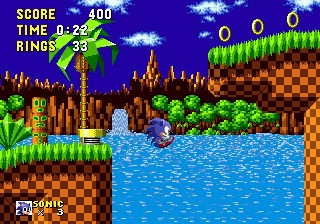


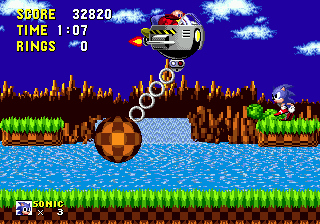
|
Marble Zone -- These crumbling ruins were (perhaps injudiciously) built in a steamy volcanic region. Move quickly along platforms floating in
lava - the dry grass on top easily catches fire. Push stone blocks into pools of magma for a safe ride. Bonus points are awarded for the
destruction of priceless historical architecture: the gray bricks provide the same multiplier bonus as enemies. (At one point in Act 2, it's
possible to smash 17 blocks in succession. The last two are worth a whopping 10,000 points each.)



Boss: A wide lava pit lies smack in the middle of the arena, leaving the two edges as the only safe havens. Eggman flies back and forth at
the top of the screen, dropping little flames onto one edge at a time: when the flame hits, a brief fire explodes across the platform.
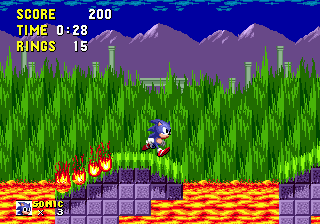
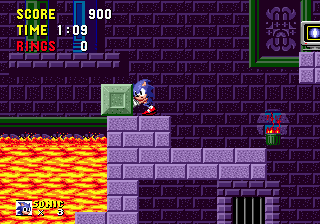

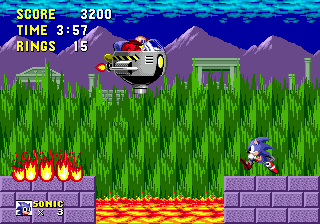
|
Spring Yard Zone -- This dark mountain city forms a giant pinball arena with steep slopes and bumpers aplenty. Elevator platforms offer slow
escape from deep pits. Look for hidden shortcuts behind walls, but watch for spiky rotating bars. Act 2 features two possible exits.




Boss: Eggman hovers overhead above a bridge of blocks. When he's right above Sonic, he'll drop down and attempt to make shish kehog with a
long, probing spike: dash out the way and the Doc instead skewers whichever block you were standing on, shattering it in the process. As the battle
wears on, the block bridge becomes increasingly sparse, so make with the haste.
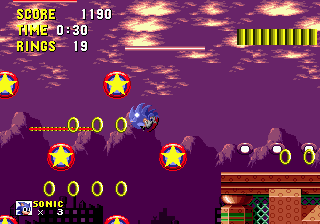
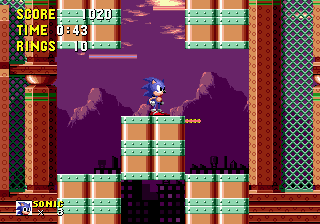

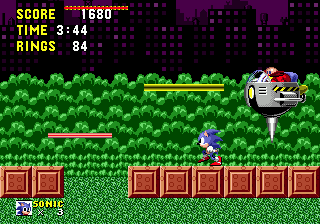
|
Labyrinth Zone -- The ancient ruins form an underground maze, sometimes submerged, sometimes dry. When underwater, Sonic's movement becomes
slow and sluggish, and he can only hold his breath for so long. As his oxygen supply begins to wane, a countdown appears above his head: if it
reaches zero, you lose a life. If you can't get to the surface in time (and sometimes you just can't), leap into one of the giant air bubbles that
rise from clusters on the ground.



Boss: The bad Doc makes his escape through a narrow vertical corridor laced with spears and other traps. Water is rapidly filling the passage
from below, so dodge the obstacles and keep moving up. Survive all the way to the surface (a tricky affair) where Eggman is helpless.

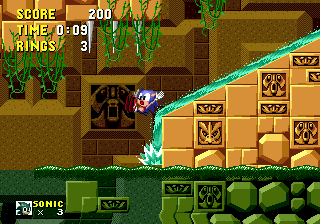
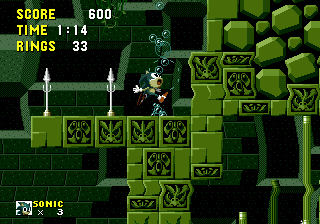
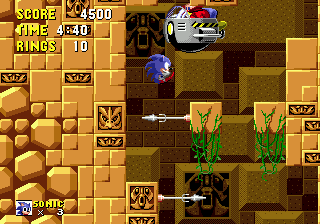
|
Star Light Zone -- This starry aerial highway is laced with large fans that impede your progress: some shut off periodically while others
continue running for all eternity. Use seesaws to bounce to higher regions of the stage, but be mindful of the flashing mine: you need it for
ballast, but it inflicts damage if touched.


Boss: Three teeter-totters line the arena. Eggman, as per usual, flies around overhead, occasionally dropping mines onto the seesaws below.
The mines explode upon impact or after a few seconds, so you have to work fast. You can either catapult the mines back up at his eggness or stand on one
end of the totter and let a falling mine spring you into the air.

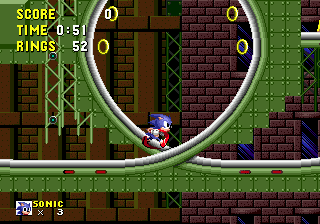
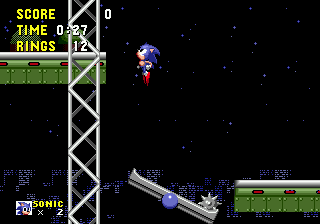
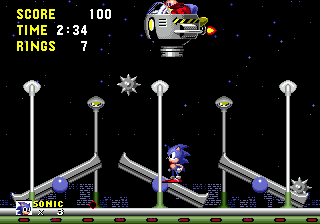
|
Scrap Brain Zone -- Eggman, who is probably not an environmentalist, likes to while away his days in this grimy, polluted industrial city.
Conveyor belts make for dangerous passage with smashing pistons looming overhead. Spinning platforms offer no support: wait until they stop moving
before you leap on top. Large round platforms have their own gravitational pull: jump to break free of their clutch. The factory scenario is
dropped entirely for Act 3, which is a gray chunk of Labyrinth Zone.






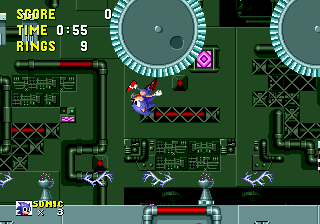
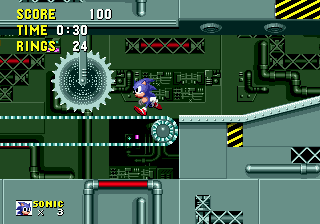
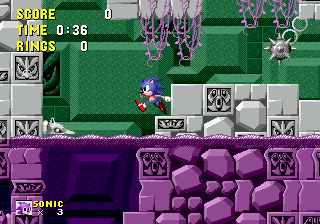
| |
Final Zone -- In the final confrontation, Eggman escapes into a small room lined with 4 giant, pounding pistons. Only 2 pistons thrust forth
at a time, and Eggman can be found cowering in one or the other: anticipate this location and attack quickly. After each thrust, 4 sparks form at
the top of the screen and home in on Sonic's general direction. Note that Sonic has no Rings with which to do battle, so if you sustain even a
single hit, you have to start the whole thing over.
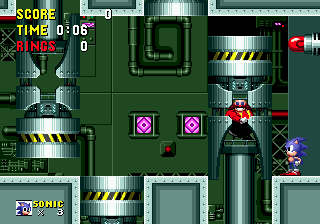

|
If you fail to concern yourself with Chaos Emeralds and complete the game short a few, your joyful ending sequence is spoiled by Eggman,
who triumphantly juggles the leftover Emeralds and challenges you to "Try Again." To get the good ending, you need all 6 Emeralds which can only be
acquired from the game's 6 Special Stages. To access a Special Stage, cross the bonus plate in Act 1 or 2 of any Zone with at least 50 Rings on hand: you'll
see a humongous rotating Ring hovering over the plate. Leap in to be warped to the Special Stage. (Note that special Rings do not appear in Scrap Brain, so
make sure to nab all six by Star Light Act 2.)
Each Special Stage is a 360° rotating maze in which Sonic - in his trademark spin pose - gets bumped around like a marble in a labyrinth
board. Somewhere in the maze lies the Chaos Emerald, surrounded by a barrier of multi-color crystal blocks. Break through the barrier and grab the Emerald
to clear the stage. You can also exit the maze by hitting any of the numerous Goal blocks, but you'll forfeit your chance at the Emerald.

|
Ring (リング) -- Grab 50 to earn a Continue, worth a full set of 3 lives.
|

|
Bobbin (ボビン) -- Bump into one to be sent flying. Unlike the main game, Bobbins don't dispense points in the Special
Stage.
|

|
Reverse (リバース) -- Reverses the rotation of the maze.
|

|
Up (アップ) -- Increases the rotation speed of the maze.
|

|
Down (ダウン) -- Decreases the rotation speed of the maze.
|

|
Hashira (ハシラ) -- Harmless posts that provide a safe surface to jump off of. When you cross a row of transparent
Hashira, they become opaque and form a barrier to keep you from falling back.
|

|
Color Block (カラーブロック) -- Multi-colored crystal blocks that guard the Chaos Emerald. Bump
into each one 5 times to change its color and make it disappear.
|

|
Goal (ゴール) -- Touch one of these to exit the Special Stage, but you'll forfeit your chance at the Chaos Emerald.
|

|
Chaos Emerald (カオスエメラルド) -- These jewels have no function during the game proper, but
collect all 6 to access the hidden ending. There's one in each Special Stage.
|


:: Comparison ::
In the late 80's and early 90's, Sega Europe released a modified version of the Master System and Mega Drive hardware for use in arcades.
The multi-cart system was known as Mega-Tech, and the JAMMA version (Mega Drive only) as Mega Play. The motherboard could host up to eight cartridges at a
time, from which players could choose whichever they wanted to play. Among the supported games available for both Mega-Tech and Mega Play were Sonic the
Hedgehog and Sonic the Hedgehog 2.
The Mega-Tech version of Sonic is mostly identical to the European Mega Drive version. The only big difference is that there's an
ever-present countdown restricting your play time. You get an additional 3 minutes for each coin you insert. The Mega Play version has a few differences.
Firstly, it's based on the second revision of the game, complete with scrolling clouds. The biggest change is that the clock counts down, and time limits
for each Act are quite strict. (Fortunately, if you die and touched a Start Marker, you'll begin at the Start Marker with a reset countdown.) 1ups are
ineffective: if you want to continue your game, you need a pocket full of quarters. There are only four Zones: Green Hill, Spring Yard, Star Light, and
Scrap Brain, the lattermost of which is missing its final Act. You can't enter any Special Stages. Even if you jump into the giant Ring, you'll just start
the next Act. Finally, there's no credit roll: complete the game to enter your initials on a high score screen. Time limits for each Act are as follows:
- Green Hill Zone, Act 1 -- 0'50"
- Green Hill Zone, Act 2 -- 1'00"
- Green Hill Zone, Act 3 -- 1'50"
- Spring Yard Zone, Act 1 -- 2'10"
- Spring Yard Zone, Act 2 -- 1'50"
- Spring Yard Zone, Act 3 -- 3'00"
- Star Light Zone, Act 1 -- 2'00"
- Star Light Zone, Act 2 -- 2'30"
- Star Light Zone, Act 3 -- 4'00"
- Scrap Brain Zone, Act 1 -- 3'00"
- Scrap Brain Zone, Act 2 -- 3'30"
- Final Zone -- 4'00"




In late 2005, Panasonic released their FOMA P701iD and P901iS mobile phones, each pre-loaded with a reproduction of Sonic 1. The game is a
fairly faithful port of the Mega Drive original minus some bells & whistles. Only the Green Hill Zone is playable out the box, but additional stages can be
downloaded. Enemies are sparse and don't release frolicking animals upon defeat, and Special Stages have been removed entirely. To compensate for the
downgrades, the mobile version offers unlimited continues, a save feature, and an online ranking for high scores. Additionally, each phone model includes 2
original Sonic-themed screensavers.
Sonic 1 mobile was also released in Europe, embedded in Panasonic's VS3, VS7, SA6, SA7, MX6, and MX7 models. In the US, the game was
distributed through Verizon Wireless.
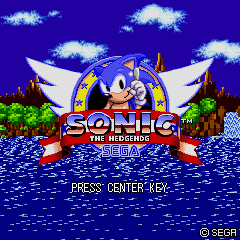
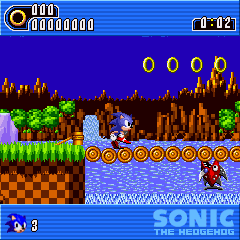
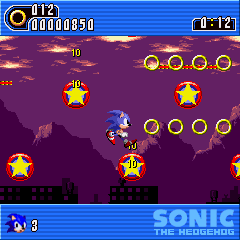
In November 2006, Sega of America released Sonic the Hedgehog Genesis for Nintendo's aging Game Boy Advance. Sonic Genesis is not an
emulated version of the original game (the GBA's CPU is insufficient for accurate Mega Drive emulation) but is a scaled down port. To be more precise, a
buggy hack job of a port that manages to utterly destroy every aspect of the original game from the physics to the music. Players who can find the strength
of will to slog through the broken mechanics can play a new "Anniversary Mode" with Spin Dash enabled (ala Sonic Jam). Like the mobile version, a stage
select feature allows players to the start the game from any previously accessed Zone. Clear the game to unlock the Juke Box, a sound test.
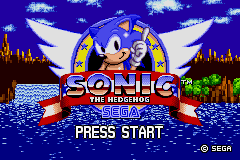
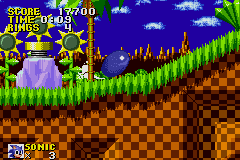
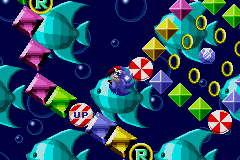
:: Lost in Translation ::
The original international versions of Sonic 1 are identical, but a follow-up revision was soon released in Japan. In the second revision,
the clouds at the title screen and Green Hill scroll (rather speedily) from right to left. The underwater segments of Labyrinth Zone feature new ripple
effects and the stage order at the level select menu has been corrected. This enhanced revision was only released in Japan.
Alot of the background story was left out of the English language manuals. No mention is made of South Island or the legend behind the
Chaos Emeralds. Enemy names are changed and Sonic's animal buddies are left nameless and ignored. Most significantly, Dr. Eggman's name is changed to Dr.
Ivo Robotnik, presumably due to copyright concerns. (The Robotnik name would later be intentionally phased out with Sonic Adventure, but
interestingly, was officially acknowledged even in the Japanese continuity as of Sonic Adventure 2.)
:: Codes ::
Level Select:
- Revision 1: At the title screen, press:
    .
You should hear a Ring chime. Now hold down A and press START. .
You should hear a Ring chime. Now hold down A and press START.
- Revision 2: At the title screen, press:
      .
You should hear a Ring chime. Now hold down A and press START. .
You should hear a Ring chime. Now hold down A and press START.
Slow & Frame Skip:
- Revision 1: At the title screen, press: C C
    .
You should hear a Ring chime. Begin the game as normal. Pause at any time and press A to reset the system, B for slow motion, or C for
frame-by-frame movement. .
You should hear a Ring chime. Begin the game as normal. Pause at any time and press A to reset the system, B for slow motion, or C for
frame-by-frame movement.
- Revision 2: At the title screen, press: C C
      .
You should hear a Ring chime. Begin the game as normal. Pause at any time and press A to reset the system, B for slow motion, or C for
frame-by-frame movement. .
You should hear a Ring chime. Begin the game as normal. Pause at any time and press A to reset the system, B for slow motion, or C for
frame-by-frame movement.
Debug Mode:
- Note that this code works only on US and European consoles. At the title screen, press:
 C C C C C C .
You should hear a Ring chime. Hold down A and press START. Continue to hold A until Sonic appears on screen. Press a button to begin
construction: .
You should hear a Ring chime. Hold down A and press START. Continue to hold A until Sonic appears on screen. Press a button to begin
construction:
A = Changes highlighted item
B = Toggles between items and Sonic
C = Places highlighted item
:: Behind the Screens ::
In April 1990, Sega challenged its employees to come up with a game that would demonstrate the power of their 16-bit Mega Drive console
along with a character who could become the company's official mascot. An enthusiastic young staff in the AM8 R&D division began brainstorming ideas, and
the final consensus was that the game should be fast and simple. The lead character needed a strong personality and a unique look, and toward this end
designer Naoto Ohshima created a series of preliminary sketches ranging from bulldogs to bearded samurai. In the meanwhile, lead programmer Yuji Naka (who
had previously worked with Ohshima on Phantasy Star II) constructed a high speed graphics engine with numerous layers of parallax scrolling: exactly
the sort of visual tour de force Sega was looking for to separate the Mega Drive from other systems available at the time.
As the game began taking shape, it became evident that a full-time lead designer was needed to coordinate the project, but none of the
staffers were free to take the responsibility. World politics, however, produced a quick fix: Hirokazu Yasuhara was scheduled to move to the US and join
Sega of America product manager Mark Cerny in establishing a Western-based R&D group. However, the start of the Gulf War postponed Yasuhara's scheduled
departure by three months. Naka, seeing that Yasuhara was free, asked him to fill in as a temporary director until a permanent replacement could be found.
The delayed traveller agreed and became quite engrossed in the project, drawing out detailed level maps on paper. In the end, Yasuhara's departure was
postponed a full year and he remained with the Sonic project all the way through.
Among the early concepts was that of a speedy rabbit character with the ability to pick up and throw objects using his long ears. This
idea was ultimately rejected because the team felt that the extra mechanic slowed the game down. Eventually the idea of a rolling attack was formed and
from this concept Ohshima narrowed the potential heroes down to an armadillo and a blue hedgehog. The hedgehog won out due to its "spiky" nature, but it
wouldn't be until the very end of the project that a suitable name was chosen for Sega's edgy new star. (The runner-up armadillo, Mighty, was revived
several years later for a starring role Sega Sonic the Hedgehog, Sonic's coin-op debut. The long-eared rabbit reject, meanwhile, rose from the ashes
as cult favorite Ristar the Shooting Star.)
With all the energy being put into perfecting the game's look and feel, the enthusiastic staff decided that professional talent from the
music industry should be tapped to compose the accompanying soundtrack. Sega approached up-and-coming Japanese pop band Dreams Come True, and successfully
wooed band leader Masato Nakamura. Dreams Come True was preparing a tour to promote their third album, Wonder 3, and Sega stepped in as a sponsor for the
campaign. Sonic was painted on the sides of the tour trailer and pamphlets advertising the game were handed out to concert-goers, offering a glimpse of the
game even before media coverage.
Despite strong enthusiasm for the project in the studio, it drew only scorn and concern from Sega's American marketing division. Sonic was
conceived as a global mascot, and key players on the US side felt that the character lacked the appeal needed to achieve success in the Western market. In
those days there was a large rift (almost a rivalry) between the home and overseas branches of the company, but the Japanese office had the final say, and
Sonic was released without changes. Despite Sega of America's predictions, the game became an instant hit in the US, catapulting the company from an
also-ran in Nintendo's shadow to the market leader. (Ironically, Sonic achieved only modest success in Japan, a trend which continues to this day.)
:: Notes ::
Flicky: Although these days she's relegated to bit parts, the bluebird named Flicky was once one of Sega's biggest stars. Flicky, a Sega
arcade game released in 1984 on System 1 hardware, put players in control of its namesake protagonist, a little bird out to save her children from ravenous
housecats. The object is to catch all of the baby birds (Pio-pios) in the stage and take them to the exit. The Pio's form a chain behind Flicky as you
collect them; points are multiplied for each Pio you have when you reach the exit. Avoid housecats (Nyan-nyan) and iguanas (Choro). If an enemy touches
your Pio chain, all the inflicted Pio's will separate themselves and run off. If Flicky herself takes damage, the entire chain scatters. (The character
Flicky made cameo appearances in many Sega games in the late 80's, including TeddyBoy Blues, SDI, Flash Point, Super Monaco GP,
and Bloxeed.)
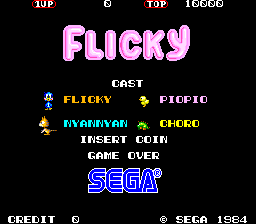



Cameltry: The game's Special Stages were heavily inspired by Taito's Cameltry, an arcade title released in 1990 on F1 System hardware (and
later ported to Super Famicom). Players use a control dial to rotate a 2D maze with the aim of navigating a lifeless marble through its many corridors. The
object is to reach the "GOAL" block of each maze within the time limit.

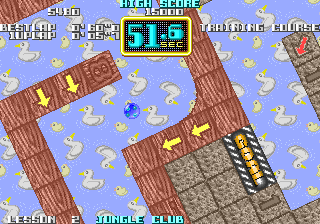
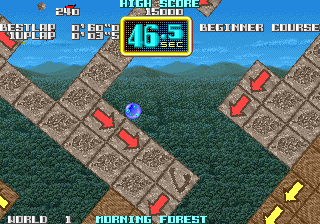

Dr. Eggman: Series villain Dr. Eggman - rotund, mustachioed, bald and bespectacled - draws his peculiar appearance (and name) from a number of
sources. Most obviously, he comes off as a caricature of 26th US President Theodore Roosevelt (1858-1919), best remembered for his bushy mustache and broad,
toothy grin. The evil Doc's name can be traced to the lyrics of a 1967 Beatles song, "I am the Walrus." Quoth the song: "I am the eggman, they are the
eggmen; I am the walrus, goo goo g'joob." (It was apparently because of this association that Sega of America chose to rename Eggman for his US debut.) A
more recent (and obvious) inspiration is the old engineer from Studio Ghibli's 1986 animated classic,
天空の城ラピュタ (Castle in the Sky).

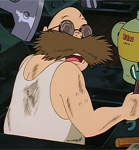
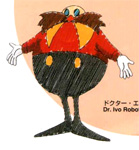
:: Miscellanea ::
- Sonic was originally a much lighter shade of blue, which is evident in most of the concept art. His sprite was darkened at the last minute because it
was difficult to see against Green Hill's ocean background.
- The BGM for Star Light Zone inspired the Dreams Come True song 薬指の決心 ("Kusuriyubi no Kesshin", literally, "decision of
the ring finger"). The song is available on the "Million Kisses" album, released November 15, 1991.
- Sonic Team originally wanted to add a scene in the first level where Sonic was being chased by a large boulder ala Indiana Jones. In the end, it
couldn't be done, although (much like the object-throwing maneuver that had to be cut) this vision came to fruition years later with Sonic Adventure.
- The visuals for Green Hill were inspired by computer-generated 3D graphics, an infant style that was gaining prominence at the time. Of the game's 6
stages, Green Hill took the longest to complete (a full half year), as the graphics were redone several times.
- Spring Yard was the first stage to be designed and finalized.
- Labyrinth was originally intended to be the second stage, but was pushed back in the level order because the designers felt it was too difficult for so
early in the game.
- Sonic was originally intended to be the star singer in a rock band. An unused sound test graphic features Sonic singing with his posse: Max the Monkey,
Mach the Rabbit, Sharps the Chicken, and Vector the Crocodile. None made it off the drawing board except for Vector, who four years later earned a starring
role in Chaotix.
- A springy rabbit enemy (dubbed "Splats" by Sega of America) never made it into the final version of the game, but apparently licensors weren't paying
attention because the lost robot appears in several toy products released in the US and Europe, including the Archie comic book.
Written content and original graphics copyright © 1997-2008 Jared Matte. Hosting and administration thanks to Nathan Tsui. Sonic the Hedgehog characters,
logos, and images are trademarks of SEGA Corporation. The GHZ is an independent fansite and is not affiliated with SEGA
Corporation.
|


































































































 .
You should hear a Ring chime. Now hold down A and press START.
.
You should hear a Ring chime. Now hold down A and press START.
